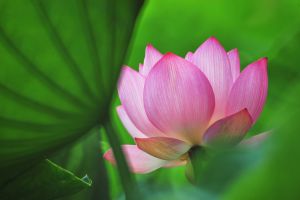 On April 28, 1253, at the Seicho temple in what is today Chiba prefecture in Japan, Nichiren Daishonin recited Nam Myoho Renge Kyo publicly for the first time. In this way he established the chanting of Nam Myoho Renge Kyo as the essential practice of his teaching, a practice that allows all human beings to develop their innate wisdom.
On April 28, 1253, at the Seicho temple in what is today Chiba prefecture in Japan, Nichiren Daishonin recited Nam Myoho Renge Kyo publicly for the first time. In this way he established the chanting of Nam Myoho Renge Kyo as the essential practice of his teaching, a practice that allows all human beings to develop their innate wisdom.
Nichiren recognized that the 28 chapters of the Lotus Sutra in their entirety were an explanation of the Mystic Law (Dharma), which is Myoho Renge Kyo. He identified Myoho Renge Kyo as the ultimate reality of all phenomena and also as the Buddha nature of all beings.
Myoho Renge Kyo is the title of the Lotus Sutra in the Chinese translation by the great Indian scholar Kumarajiva (344 – 413).
Please find below a brief and inevitably limited explanation of certain key concepts expressed in this phrase:
Nam
Nam is a Sanskrit word that can be translated as “to devote oneself to,” in this case to devote our life to and harmonize it with Myoho Renge Kyo, the ultimate reality of life or the Law of life (Dharma). Nam expresses both action and attitude. It therefore represents the appropriate action and the correct attitude for attaining Buddhahood in this life.
Myoho
Literally, Myoho expresses the relationship between the inherent life of the universe and its various manifestations. Myo designates the actual essence of life, which is “invisible” and surpasses intellectual understanding. This essence is, however, expressed in a tangible form (ho) that can be apprehended by the senses. Phenomena (ho) change, but the constant reality inherent in all phenomena is called Myo.
Renge
 Renge means “lotus flower.” Because it produces its flower and fruit at the same moment, the lotus symbolizes the simultaneity of cause and effect. The circumstances and quality of our life are determined by the specific causes and effects, both good and bad, that we accumulate (through our thoughts, words, and actions) from one instant to the next. This is what we call “karma”. The law of cause and effect explains that each person is directly responsible for his or her own destiny. We create our destiny, and we can change it. Chanting Nam Myoho Renge Kyo is the most powerful cause that we can create, because it produces at that very moment in the depths of our life the effect of Buddhahood, which will then, without fail, emerge and become manifest at the right time.
Renge means “lotus flower.” Because it produces its flower and fruit at the same moment, the lotus symbolizes the simultaneity of cause and effect. The circumstances and quality of our life are determined by the specific causes and effects, both good and bad, that we accumulate (through our thoughts, words, and actions) from one instant to the next. This is what we call “karma”. The law of cause and effect explains that each person is directly responsible for his or her own destiny. We create our destiny, and we can change it. Chanting Nam Myoho Renge Kyo is the most powerful cause that we can create, because it produces at that very moment in the depths of our life the effect of Buddhahood, which will then, without fail, emerge and become manifest at the right time.
Even though it grows and blooms in muddy ponds, the lotus flower is perfect and immaculate; this symbolizes the emergence of Buddhahood from the depths of the life of an ordinary person.
Kyo
Literally, Kyo means “sutra, voice, or the teaching of a Buddha.” It can also mean sound, rhythm, or vibration. The Chinese character for Kyo originally represented the threads of a woven fabric, symbolizing the continuity of life throughout past, present, and future. In a broader sense, Kyo expresses the idea according to which everything in the universe is a manifestation of the Mystic Law (Dharma).